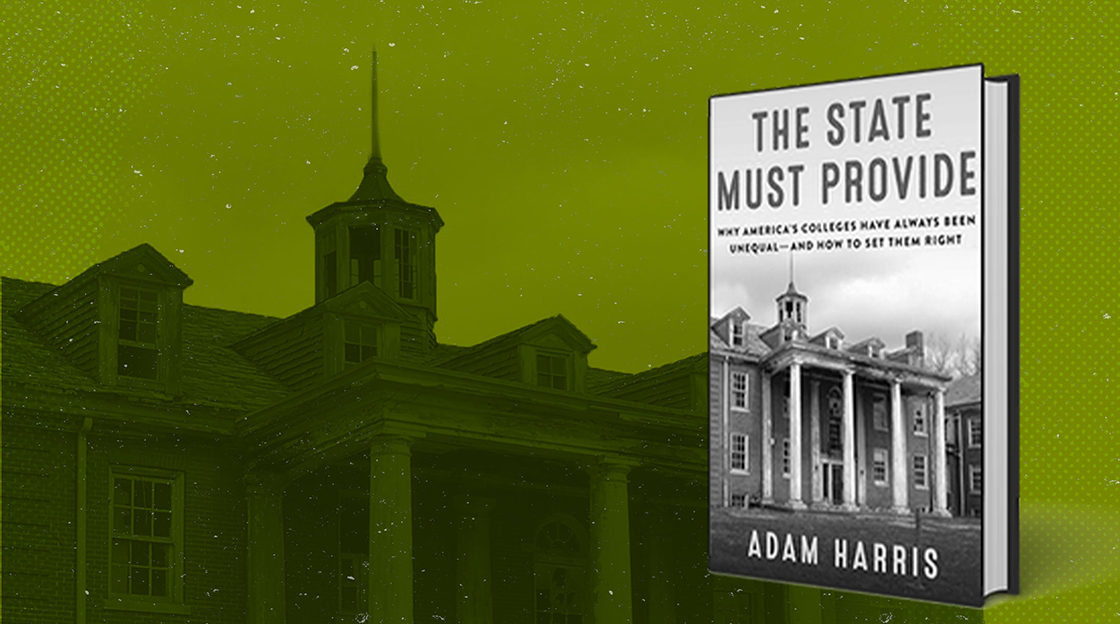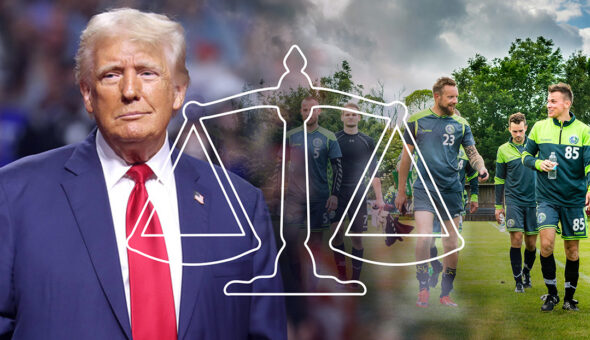Read the full transcript here:
Kevin Tyler:
Higher Voltage is presented by Squiz. University websites are filled with great information, but too often users can’t find what they’re looking for, even through the internal site-search feature. Funnelback, the site-search product by Squiz, changes the way people engage with content by revolutionizing search. It provides key insights that can drive the creation of content that your users are actually looking for, and that’s just the start of what Squiz can do for your higher-ed institution. Visit Squiz.net, that’s S-Q-U-I-Z.net, to see how Funnelback by Squiz can create a smarter site-search option for your institution’s website today.
Kevin Tyler:
Hello, and welcome to Higher Voltage, a podcast about higher education that explores what’s working, what’s not, and what needs to change in higher-ed marketing and administration. I’m your host, Kevin Tyler. Hello, everyone. Thank you for joining us today. I’m excited about today’s conversation with Adam Harris. Adam Harris is a staff writer at The Atlantic, but has written recently a book called The State Must Provide, which has become one of my favorite books about higher ed and the history of higher ed that I share with as many people as possible.
Kevin Tyler:
Before joining The Atlantic, he was a reporter at The Chronicle of Higher Education, covering federal education policy and HBCUs, or Historically Black Colleges and Universities. Also worked at ProPublica, and his writing has been featured on BBC, Bleacher Report, Ebony Magazine, and he is a frequent guest on CBS News, MSNBC, and radio stations across the country. Adam, it’s such a pleasure to have you here. It’s an honor to talk to you. I’m a huge fan of yours for a long time, and I’m excited to have this conversation with you.
Adam Harris:
Absolutely. Thanks so much for having me. I’m looking forward to it.
Kevin Tyler:
Before we dive into the meat of the book, I’m just curious why you wrote this book now. What was the impetus for it to come out when it did?
Adam Harris:
Yeah. So when I was leaving The Chronicle, I wrote a story that was effectively about Mississippi, the HBCUs and Mississippi’s long struggle for effectively equitable funding in their higher education system. Mississippi was one of the states that hadn’t proven to the federal government that it had desegregated its higher education system by the 1990s. And so I wrote about this 30-year case that effectively showed what it meant for a higher education system to desegregate its colleges.
Adam Harris:
And after I finished that piece, it received a large response, but my thought was, “Well, the thing that I wanted people to really get from that was that this wasn’t just central to Mississippi’s HBCUs. This wasn’t just this one state.” This was Alabama. This was North Carolina, which settled in the 1980s. This was Kentucky. This was Maryland, right? There are a lot of states that are still going through these… that historically had these issues and still deal with issues with a fundamentally flawed higher education system, and dealing with how they’ve treated their historic Black colleges, dealing with how they’ve treated their tribal colleges.
Adam Harris:
But for HBCUs in particular, I didn’t think that there was really a place where you could sort of… as opposed to viewing HBCUs as on the periphery of higher education. But if you view them as an integral part of the higher education system, I thought there needed to be a book that did that work, that put HBCUs in that central place that they deserve while also examining the broader inequalities of higher education. So I thought that all of those things kind of came together on top of HBCUs being in this sort of renewed spotlight probably since 2016, 2017. I mean, HBCUs as both a safe haven, and it’s also a place that has been attacked from bomb threats to this sort of string of things. I just thought it was a perfect moment to capture and replace them in their central place in the higher education system.
Kevin Tyler:
Yeah. And I love watching… I hate the reasons for it, but I love watching applications at HBCUs rise and HBCUs getting the attention that they deserved for quite some time. Your book talks about the history of HBCUs in a really interesting way. It splits the history, historical documents with stories of actual people going to these schools and their creation in a lot of the Southern states. I’m curious if you could just give a high-level overview for our listeners of how HBCUs have been critically and historically underfunded. And I’d love to hear you explain things, including the Ayers decision, that you’ve included in the book as well, because those are really important facts that really have current-day implications that we’ll start to see here soon.
Adam Harris:
Yeah. So there are a couple of different ways. I think starting with just a working definition of HBCUs, they’re institutions founded primarily after the Civil War, and there were a couple founded before the Civil War, that were created to educate students who the rest of higher education effectively shut their doors to. Right? You think about a state like Mississippi, where the faculty in the late 1860s, early 1870s were effectively saying that we would rather close our doors and all of us resign than to enroll a Black student. Meanwhile, you have a place like Alcorn State, which is a historically Black college, that received a guaranteed appropriation of $50,000 a year for at least a decade beginning in 1871. In 1875, that is slashed to $15,000 a year. A year later, that’s slashed again to $5,500 a year. So you can start to see how the gulf in funding disparity begins to grow between a place like Ole Miss that’s like, “Hey, we’d rather close than enroll Black students,” and a place that’s enrolling Black students having its funding stripped from it.
Adam Harris:
There are a couple of different federal programs that, I think, really hit on the way that these disparities sort of were exacerbated, right? One of the largest giveaways to American higher education in history is the Morrill Act, where the federal government gives 17 million acres of land that can be sold, land that’s, of course, expropriated from Native American tribes that can be sold in order to build or fund an institution. But the catch was, of course, this is 1862, that the students who attended those institutions were most often white. Black students were not attending these original land-grant institutions.
Adam Harris:
1890 comes around, and they pass the Second Morrill Act that says, “We will give you more money,” because the predominantly white institutions were like, “Hey, we need more money because look at what we’re doing with this little bit of money. Imagine what we could do with more.” So effectively, the government’s like, “We’ll give you more money, but you can’t make any differentiation in enrolling into a state higher education system white or Black students, but you can operate a separate system of institutions for Black students.” So some of that Second Morrill Act money ends up going to help fund these HBCUs, but it pales in comparison to that first Morrill Act. So between the basis of the funding mechanisms for these two public institutions, a predominantly white institution like Auburn versus an Alabama A&M, or a North Carolina State versus a North Carolina A&T, sort of thinking about the recipients of that land-grant funding, the divide in the education funding becomes more clear.
Adam Harris:
By the time you get to the 1970s, the federal government is looking into… They’ve had the Civil Rights Act, and now you have Title VI and you have all of these things that are effectively saying, “Hey, you can’t discriminate, or else we’ll take your funding away.” And HBCUs, the Black students who attended them and their families, they would typically… They were effectively saying, “Hey, we are going to test these laws because these states are inequitably funding their higher education systems.” And in 1975 in Mississippi, a group called the Black Mississippians for Higher Education filed a lawsuit against the state, arguing that it had routinely and consistently underfunded its historically Black colleges. That it built colleges right down the road from the HBCUs that received greater shares of funding that would duplicate the programs, which sort of limited their ability to recruit students.
Adam Harris:
It worked its way all the way up to the Supreme Court in 1992. And that case, known as the Ayers case, is what decides and establishes these sort of guidelines for what it takes for a state to desegregate its higher education system. Ultimately, the case goes back down to the lower courts, works its way into a settlement, right? It had been roughly 30 years, about 25 years since this case had started, and people were getting old. One of the original plaintiffs had died. So they ultimately settled for $500 million across 17 years split between the three HBCUs in the state. To put that into context, the University of Mississippi can make $500 million in five years from private donations. So there’s still that disparity, and we know that these settlements aren’t necessarily the way to get towards solving for that legacy of discrimination in funding.
Kevin Tyler:
I appreciate you walking through that. I’m not sure how many people understand how HBCUs were developed. I think that I was having a conversation with a friend a couple of days ago, who I mentioned I was preparing for this interview, and he’s like, “Oh, I thought HBCUs were just another option. Like, you could just go… They were just kind of developed as an alternative.” And I was like, “That’s not the history. I’m going to send you this book right now.” So I think there is the story that surrounds the creation of HBCUs and the fact that no new ones can ever be created that really makes it kind of an endangered species in my estimation. It’s a group of schools that are serving a population that really needs the opportunity and really does great work in the face of being underfunded.
Kevin Tyler:
I think the other part about this is the immediate equation of quality with the… So you can make these assumptions about how good the school is, and when you go see it, you can tell when a school is underfunded. I mean, there’s no question about what… So there’s all these other secondary implications to this, and it makes recruitment hard. It makes sustaining hard. It makes all of it just very difficult. So I appreciate you walking through that.
Adam Harris:
Yeah. And actually to your point… Sorry.
Kevin Tyler:
No, no, no.
Adam Harris:
To your point about the idea about the quality versus the sort of tags that gets applied to the institutions, I often think about a place like North Carolina A&T, where despite the legacy of underfunding, it’s still the third highest research-producing public institution in the state of North Carolina, right behind UNC Chapel Hill and North Carolina State. And that’s with the limited funding that they’ve received historically. They’ve been able to go out and get that money elsewhere. They’ve still been able to do this remarkable work. My thing is always, even though they’ve been able to do all of this in spite of, they shouldn’t have had to do it in spite of. Right?
Kevin Tyler:
Exactly, exactly.
Adam Harris:
They should have been showered with the funding for the work that they were doing.
Kevin Tyler:
One of my favorite lines in the book is right up in the beginning. By the way, I should say that the amount of highlighted passages in this book, in my copy, is probably absurd. There are so many great, great pieces of information and the way you frame some ideas that are just really compelling. One of my first favorites was this one, “Higher education is organized so the institutions with the fewest minority students have the most money, the best services for students, and the highest prestige. That is not by coincidence, but by design.” I am wondering, what do you think it will take for higher education to develop the courage to redesign itself to a next generation of classes, a more diverse class, if they even want to do that?
Adam Harris:
I think at a state level, of course, we have to have… Well, the conversation about what state legislatures are currently doing is a completely different one. But I think just thinking about state higher-ed executive officers, thinking about their state’s funding formula for higher education, whether it is being set up in an equitable way: considering how many students are Pell eligible that an institution is enrolling, how many minority students is an institution… students from minoritized and marginalized populations is an institution enrolling. And I think all of those sort of things should factor into the funding that these institutions are receiving, because if you have a place like Auburn, which has known since the 1980s that it is one of the most segregated institutions in the state of Alabama, for it to continue to have a 5% Black student population, in total numbers a lower Black student population than it had in 2002, there should be something that is triggered to deal with that fact because Alabama… It’s not like Alabama has some dearth of Black citizens, right? My family’s from Alabama. It is a very pigmentized state. So that is one way.
Adam Harris:
I think another thing is just thinking about the institutions that benefited from the financial benefits of slavery, segregation, Jim Crow, what do those institutions owe to the institutions that were effectively being blocked from that funding at that time, right? What does a University of Kentucky, knowing that because the state would not send Black students to the UK, they would instead take $5,000 from Kentucky State’s budget and say, “Okay, this is what we’re going to use to send Black students out of state for the year,” knowing good and well that they weren’t going to spend that full $5,000 to send Black students out of state for graduate education. What does a place like University of Kentucky owe to a Kentucky State University? What does the University of Mississippi or Mississippi State owe to the Black colleges in the state, or even University of Southern Mississippi? And how does the higher education governing body in the state, how is it able to consider the ways that it is using some of its discretionary funding in ways that more equitably build out their higher education system?
Kevin Tyler:
And that piece that was in the Chronicle that was adapted from the text, which you just referred to, What White Colleges Owe Black Colleges, I thought was completely compelling. And in it, you suggest that, like you mentioned, wealthy institutions who benefited from slavery could have some responsibility to share the wealth with those egregiously underfunded institutions. I’m wondering if you have an idea of how much money that might look like, just for context for our listeners, because I’m not sure people really understand how underfunded this group of institutions is.
Adam Harris:
Yeah. There was an article in Forbes by Susan Adams earlier this year, where they effectively quantify the underfunding, just doing it kind of per pupil, basically places that had an HBCU and a predominantly white institution in the land-grant colleges in the state. So a place like North Carolina A&T, which I think was at the top of the list, had been underfunded by something like $2.67 billion since 1987. They’re difficult to conceive of because it’s like, if that’s just since 1987, what is the larger factor, right? Knowing that the Truman Commission in the 1940s said that Kentucky was funding its Black students and its white students at the worst rate in the nation at 42 to one. And no state in the nation, no state or territory in the nation came even close to actually matching. I think the closest was a three-to-one ratio in the District of Columbia.
Adam Harris:
So you’ve seen these settlements worth $500 million in Mississippi, $577 million in Maryland, 200-something million dollars in Tennessee, and you look at those numbers, and you’re like, “Wow, that’s a lot of money going to these institutions.” But knowing how wealth sort of begets wealth and institutions are able to build on that momentum that they develop over years, there is untold amounts of money that has been lost by these institutions just simply for not receiving that additional funding.
Adam Harris:
I will say there was a piece from Denise Smith from the Century Foundation. It came out late last year, and she argued for a $40 billion endowment fund for HBCUs, right? Create a $40 billion endowment. That will just be so that these institutions can plan ahead for the future, right? So if each HBCU received half a billion dollars, knowing that there are about a hundred HBCUs in the US… If each HBCU received about a half billion dollars that was just for their endowment to help them begin to capacity build, help them begin to plan, then I think that that would be a solid step. But I think that the number should start closer to that 40 billion mark if you want to start dealing with some of that historical discrimination.
Kevin Tyler:
Yeah. Yeah. I don’t think that we can talk about this book without talking about rankings, because I think that that drives so much of the decisions that institutions make. I work in higher-ed marketing and branding for an agency. And so often we hear the desire for the institution, from a marketing perspective, is to elevate our spot in the rankings. But we also have heard about so many institutions wanting to recruit a more diverse class. And I am curious if you think that a focus on rankings and a focus on access can exist in the same space.
Adam Harris:
I do, if the rankings are the sort of right kind of rankings. Right? I often think of Berea. Berea College is one that carries throughout the book, and I’m always interested in Berea for a couple of reasons. One, it’s been tuition free since 1892. So I went down there when I was actually writing the book and reporting out some of the stuff for the book just to effectively ask them, “How did you do that?” And their story and the original mission and kind of how they’re trying to reclaim that mission ultimately ended up forming the backbone of the book, even though it’s not an HBCU, because I do believe that there’s this thought that you can only judge people by the standards of their time. But knowing that in the time before the Civil War, there were people thinking about equity and access in higher education, and John Fee was really interesting to me.
Kevin Tyler:
Yes.
Adam Harris:
So I think that in that same way, if you get to a foundation of rankings that is about access, that is about affordability, rather than being about selectivity, how many students you reject from an institution. I think that a focus on what is the institution that has the lowest amount of student hunger on campus, right? I would actually be really interested in that, and that would be something that an institution could absolutely boast about. Not only saying that we’re just going to cream skim and just take the top of the top students and kind of rub our hands, “We’re done. We’ve done our job of educating the brightest minds in America,” and instead focus on, “Okay, how can we enroll a student and help them get through to graduation? What can we do for socioeconomic mobility?” So considering HBCUs, how high they often perform in those socioeconomic-mobility calculators, thinking about community colleges, how often they surface in those things.
Adam Harris:
It’s always interesting to me how those institutions with the most funding, the most availability for resources, for tutoring, for all of those accoutrements that go with attending a highly, as some say, highly rejective college, all of the accoutrements that go with that, if states funded community colleges, some of the institutions that most students attend, right? If you think about people who are going to public college in North Carolina, 52% of Black students who attend public college in North Carolina go to one of the state’s community colleges. It’s like 25% go to one of the state’s HBCUs, and 22% go to the state’s 12 public PWIs. I mean, just thinking about those numbers, if you really want to think about rankings and access, then I think that you include the diversity numbers, you include the socioeconomic numbers, you include how access-oriented an institution is. I think all of that gets wrapped into rankings for how… And you attach it to maybe graduation rates to really understand how the institutions are actually serving students. I think Washington Monthly’s rankings do a really good job of that.
Adam Harris:
But in a world without rankings, what is the central purpose of higher education? And it may be to go back to what the founders were thinking of. George Washington’s first address before Congress, he’s like, “There’s nothing that better deserves your patronage than the arts and the sciences.” Right? Than higher education, because that’s where you taught people how to be a good citizen. And if we sort of loose ourself from this bind of believing that higher education is only for the uplift of that individual who is receiving a degree and is going to walk across the stage and get all the back pats, and rather, as every time somebody walks across that stage, they are a more wholly developed person; this is going to be better for society as a whole. I think that when you do that reframing that addresses both the sort of rankings conversation, because it matters less at that point, that addresses kind of how we fund higher education, because you want to fund something that is going to build out a more engaged, informed citizenry.
Kevin Tyler:
First of all, I completely agree with all the words that you just said. Loosening ourselves from that bind and repositioning the conversation around rankings to the development of good citizens, I think, is a better way to rank an institution. I just don’t understand why we can’t get to a ranking system like that. The prestige, the selectivity, or the rejectivity feels so core to the rankings conversation that it feels like it can’t ever be evolved.
Adam Harris:
It does. It will be incredibly difficult to loose ourself from rankings, in part because you’re right, the prestige sort of does beget more prestige, right? An institution that’s like, “Well, I was number one in the rankings,” and then if they just say, “Hey, we actually don’t care about the rankings,” then they’re probably going to have a couple of years where the rankings are still going to come out and they’re going to perform lower. And they are going to have some angry alumni who graduated before they enrolled a wide variety of students, and they’re going to say, “Hey, well, this isn’t the institution I attended or my grandkids attended or my kids attended.” Right? So whichever president, whichever leader that is, is going to take a lot of flak for it.
Kevin Tyler:
I’m curious about your thoughts on some of the news pieces from the last few years around the MacKenzie Scott’s gifts and people coming in and announcing at a commencement that they’re erasing student debt at HBCUs. And yes, the money, I’m sure, is helpful, but do you think it’s doing what it needs to do for HBCUs and for higher ed as an industry?
Adam Harris:
I think for HBCUs, the philanthropy is a long time coming, and any additional funding that they can receive is great. I will say the thing that always struck me, particularly about the MacKenzie Scott donations as well as some of the other donations, is the headline was almost always, “This is the largest single donation in this institution’s history.” Right? It can be $40 million. Fantastic. A $40 million gift is huge for any institution. It could be $20 million. Still, the same. 20 million is a large individual gift. It could be 15 million. It could be 10 million. It could be 5 million. Alabama A&M received a $2.2 million gift last year, and it was the largest individual gift in the institution’s 150-year history.
Adam Harris:
So when I saw the donations, my first thought was, “Wow, this is going to do a lot of good for a lot of students.” There was recently a piece that came out about what happened to MacKenzie Scott dollars at Prairie View and how they have helped the institution. So they’re undoubtedly doing good, but I often think of philanthropy and sort of the ebbs and flows of philanthropy. There was a period in the late 1870s, early 1880s, where there was some philanthropic giving to HBCUs, the developing HBCUs as well, but that sort of waned as America’s commitment to Black education waned. It’s one of the reasons why Berea had such a difficult time attracting donations with its sort of interracial model in the 1890s in Kentucky, because the spigots for funding interracial education had effectively dried up. So they changed their strategy and said that we’re… There was a piece in The Atlantic that the president of the university at the time wrote, that it was educating our ancestors in the mountains. And so effectively, we are an institution that’s going to help educate white, rural citizens.
Adam Harris:
So I think that philanthropy is great and is going to be helpful for the institutions, but it is not a salve for the systemic discrimination that they’ve experienced for more than a century at this point. And I worry at times that people will take that one or two years of really significant philanthropic giving and say, “Well, why do we need to do anything else? They just got all of that money from philanthropy two years ago. What did they do with all of that?” And it’s like, well, that’s not exactly how philanthropic giving works. Oftentimes, it’s tied to specific things on campus, right? This has to go towards the development of this sort of program. So I don’t know that it’ll have the grand impact that everyone may have expected, but I also don’t want to spit on it and say that it’s not significant.
Kevin Tyler:
Sure, sure, sure. It’s totally significant. But as you explained earlier, it could be, depending on the amount, considered a drop in the bucket compared to what is actually owed on these campuses. I do feel like it moves the conversation around the role of HBCUs in the higher-ed space, and I’m glad that more people kind of understand. And if it takes someone like MacKenzie Scott to kind of wave that flag, then fine. But it will take far more people to understand the role of HBCUs in higher ed for them to survive, even as applications rise. Also, I guess the point you made earlier in the opening around all the other kind of violence that has been threatened on these campuses, coupled with these gifts, I mean, just creates a whole other kind of story around the existence of these campuses. So I appreciate that.
Kevin Tyler:
One question that I was thinking about this morning as I was reading some stories about higher ed, there’s a lot of states who are threatening to pull funding from institutions who are moving forward with diversity initiatives, trying to dictate what is allowed to be taught in schools in terms of historical accuracy. I’m wondering what these kinds of efforts from a legislative/political perspective, is it signaling something for the future of higher ed, especially in red and/or Southern states?
Adam Harris:
It’s been interesting to both watch and cover the battles over curriculum, the battles over what students can and should learn since I started at the Chronicle, covering some of the free-speech and academic-freedom conversations and the ways that these sort of genuine threats to academic freedom are not being challenged in the same way as some of the one-off events on campuses. I think that one of the things in talking to sometimes HBCU leaders, sometimes leaders of other institutions, HBCU leaders in particular, though, when they have to go to a legislature and ask for more funding, if you have been pushing and protesting and doing X and O all year and just really being aggressive about your push for funding, they often worry that the legislators who are doing these same things, trying to ban the teaching of effectively an expanded version of history in schools, trying to smoke out people who have studied critical race theory, they’d worry that those people will say, “Hey, you said this, and so we’re actually not going to give you more funding. We’re actually going to take your funding away.”
Adam Harris:
The leaders perceive it to be a double-edged sword. They think that it’s not in the best interest of their institution at times to be as aggressive as they might otherwise. But I think generally kind of thinking forward for higher education, it really puts higher ed in a dangerous position, right? A couple of years ago, I wrote a piece that was about the growing education divide, where voters without college degrees versus voters with college degrees tended to vote for Democrats if you had a college degree and tended to vote for Republicans if you didn’t have a college degree and what sort of incentive structure that set up for American politics. If one party believes that the other party is only the party of college graduates, that only increases the incentive for them to attack higher education as the place that is developing these sort of radical elites.
Adam Harris:
So I think it does. It puts higher education in a really dark place if things continue down this path without significant pushback and saying, hey, higher ed, one, living up and continuing to profess its values, and not only profess them, but living up to those values, thinking about ways to make their institutions more affordable, thinking about ways to bring more students into the system and not only bring them in, but help them get through the system so that you don’t have so many people who, “Oh, well, I have 78 credits, but one class I couldn’t pay for, and so I had a $1,000 thing on my account. Now I can’t register for classes, and then I can’t take that class for another year, and so I end up stopping out.”
Adam Harris:
So thinking about ways to be creative to help students get to and through college in the same way that HBCUs have done a lot of this in spite of lack of funding or from threats of effectively closing. Alabama State in the 1890s, when it was moving to Montgomery, it was literally blocked from funding for an entire year. Alabama stopped funding the institution for an entire year to effectively financially starve it into closure, and it found a way through. It was through a sort of collective effort that that happened. And industry kind of has to come together and profess its values, boldly state them, and then think about ways to make itself more affordable and accessible for students.
Kevin Tyler:
I think about a conference I attended a couple years ago, and Brandon Busteed from Kaplan was one of the speakers. And in that speech, he mentioned that in America, anything that becomes politicized can never become unpoliticized. And I guess some could argue and many could argue that higher education has been… and education has been politicized since the beginning, just based on how it’s been regulated and funded, et cetera. But this feels like a new version of politics today. And I’m curious if you think that higher ed can get out of this politicized environment to rise above and actually do what it was formed to do in a more modern way, though, of course?
Adam Harris:
Yeah. So small question. I’ve been to a bunch of school-board meetings over the last couple of months. Of course, this isn’t higher ed, but just as an example of kind of where education sits in the sort of political sphere. I went to a school-board meeting in Michigan, and I ended up writing a piece about this for the Atlantic. But I went to the school-board meeting, and as I walk in, I see this group of women off to the side praying. So I’m like, hey, let me… After they finish their prayer circle, let me go over and try to talk to one of them. This was in a period where COVID cases in Michigan were very high level. They were currently in the middle of a surge.
Adam Harris:
So this group of women was sitting unmasked near each other, and I was just trying to… I wanted to go over and ask one of them a couple of questions. So I go over, and I say, “Hi, I’m a reporter with The Atlantic. I’d like to ask a couple questions.” And the first question that I get is, “Are you a liberal?” And I was like, “I’m a reporter for The Atlantic.” And then she gets more animated. She’s like, “Are you a liberal?” So I explained to her that I’m a reporter with The Atlantic. I’m just trying to understand why she came out to the meeting today. What are some of the things that are most interesting happening in their community? And eventually, we end up having a very brief conversation and interview. But it was just indicative to me of people are primed to be combative in this moment, and almost because of that, just thinking of higher ed as a political issue.
Adam Harris:
I don’t think that it goes away as higher ed being a political issue. It will continue to be a political issue, in part because one party believes it is a place where students are effectively being indoctrinated, where students are becoming too liberal. So I don’t think that that goes away. But I do think that you almost have to be optimistic to just kind of go through your day-by-day, and not even in the way of just like pure optimism.
Adam Harris:
But I do think that there is a world where higher education, if it kind of gloms onto the idea that was at the root of John Fee’s institution, thinking of the idea of God has made of one blood all the people of the Earth, that kind of thinking about spaces where folks can have equal opportunity to education, have equal opportunity to… this was also thinking communal work and communal education at the same time for Berea’s sake, then that was the way towards a more equitable future. I think that that foundation would be incredibly helpful in kind of moving things forward.
Kevin Tyler:
I think that is a wonderful place to stop, in a world that you believe is possible, and I believe that that is possible as well. I think it will take a lot of work. I do want to share with you that I talk about this book to whoever will listen to me about it. I believe that the idea of structural racism can sometimes be just too big, just too big of an idea for people to grasp in its entirety. So what I’ve started to do was buy these packs of books that break apart structural racism into the pillars that kind of define what America is about with housing, banking, medicine, like all of these kinds of ideas. Books like The Immortal Life of Henrietta Lacks, Just Mercy, The Color of Money, The Color of Law, these things that talk about the ways that the systems that govern our society are inherently racist. And I’ve added this book to those packs.
Kevin Tyler:
I think it is fascinating. I will continue to talk about it to whoever will listen to me. And I just wanted you to know from me directly how important it was for me to read this from a personal perspective, because it made me really understand why me being at the University of Pittsburgh, getting my degree in poetry meant so much, but also from a professional perspective, where I can start to introduce conversations that you introduce in your book to clients and other spaces I’m in on campuses. So I just want to say thank you personally for writing this. It is one of my favorite books I’ve ever read about the topic, and I wanted you to know that from my mouth.
Adam Harris:
Thank you so much. I really do appreciate that. It really means a lot. Thank you.
Kevin Tyler:
It’s really quite moving. I would encourage everyone to pick up a copy. We’ll have a link to it on the episode page. Adam Harris, I cannot tell you how much I appreciate your making the time for this conversation, and I hope we can stay in touch.
Adam Harris:
Absolutely. Thanks so much for having me.
Kevin Tyler:
No problem. That’s it for this week’s episode of Higher Voltage. We’ll be back soon with a new episode, and until then, you can find us on Twitter @volthighered. And you can find me, Kevin Tyler, on Twitter @KevinCTyler2.








